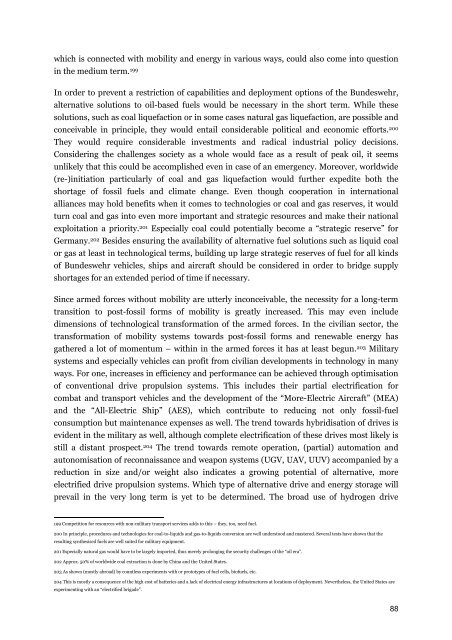PEAK OIL
PEAK OIL
PEAK OIL
Create successful ePaper yourself
Turn your PDF publications into a flip-book with our unique Google optimized e-Paper software.
which is connected with mobility and energy in various ways, could also come into question<br />
in the medium term. 199<br />
In order to prevent a restriction of capabilities and deployment options of the Bundeswehr,<br />
alternative solutions to oil-based fuels would be necessary in the short term. While these<br />
solutions, such as coal liquefaction or in some cases natural gas liquefaction, are possible and<br />
conceivable in principle, they would entail considerable political and economic efforts. 200<br />
They would require considerable investments and radical industrial policy decisions.<br />
Considering the challenges society as a whole would face as a result of peak oil, it seems<br />
unlikely that this could be accomplished even in case of an emergency. Moreover, worldwide<br />
(re-)initiation particularly of coal and gas liquefaction would further expedite both the<br />
shortage of fossil fuels and climate change. Even though cooperation in international<br />
alliances may hold benefits when it comes to technologies or coal and gas reserves, it would<br />
turn coal and gas into even more important and strategic resources and make their national<br />
exploitation a priority. 201 Especially coal could potentially become a “strategic reserve” for<br />
Germany. 202 Besides ensuring the availability of alternative fuel solutions such as liquid coal<br />
or gas at least in technological terms, building up large strategic reserves of fuel for all kinds<br />
of Bundeswehr vehicles, ships and aircraft should be considered in order to bridge supply<br />
shortages for an extended period of time if necessary.<br />
Since armed forces without mobility are utterly inconceivable, the necessity for a long-term<br />
transition to post-fossil forms of mobility is greatly increased. This may even include<br />
dimensions of technological transformation of the armed forces. In the civilian sector, the<br />
transformation of mobility systems towards post-fossil forms and renewable energy has<br />
gathered a lot of momentum – within in the armed forces it has at least begun. 203 Military<br />
systems and especially vehicles can profit from civilian developments in technology in many<br />
ways. For one, increases in efficiency and performance can be achieved through optimisation<br />
of conventional drive propulsion systems. This includes their partial electrification for<br />
combat and transport vehicles and the development of the “More-Electric Aircraft” (MEA)<br />
and the “All-Electric Ship” (AES), which contribute to reducing not only fossil-fuel<br />
consumption but maintenance expenses as well. The trend towards hybridisation of drives is<br />
evident in the military as well, although complete electrification of these drives most likely is<br />
still a distant prospect. 204 The trend towards remote operation, (partial) automation and<br />
autonomisation of reconnaissance and weapon systems (UGV, UAV, UUV) accompanied by a<br />
reduction in size and/or weight also indicates a growing potential of alternative, more<br />
electrified drive propulsion systems. Which type of alternative drive and energy storage will<br />
prevail in the very long term is yet to be determined. The broad use of hydrogen drive<br />
199 Competition for resources with non-military transport services adds to this – they, too, need fuel.<br />
200 In principle, procedures and technologies for coal-to-liquids and gas-to-liquids conversion are well understood and mastered. Several tests have shown that the<br />
resulting synthesised fuels are well suited for military equipment.<br />
201 Especially natural gas would have to be largely imported, thus merely prolonging the security challenges of the “oil era”.<br />
202 Approx. 50% of worldwide coal extraction is done by China and the United States.<br />
203 As shown (mostly abroad) by countless experiments with or prototypes of fuel cells, biofuels, etc.<br />
204 This is mostly a consequence of the high cost of batteries and a lack of electrical energy infrastructures at locations of deployment. Nevertheless, the United States are<br />
experimenting with an “electrified brigade”.<br />
88


